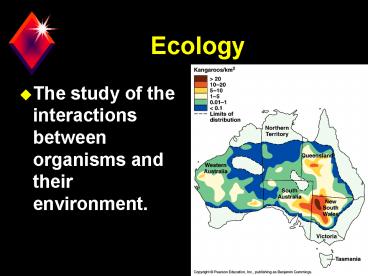Ecology - PowerPoint PPT Presentation
1 / 51
Title: Ecology
1
Ecology
- The study of the interactions between organisms
and their environment.
2
Organisms
- All living things.
- Studied at many levels.
- living things are organized from- atom to the
biosphere.
3
Levels of Organiztion
- 1. The atom, molecule, cell, tissue, organ, and
organ systems are the levels that make up an
organism. - 2. The interactions of Organisms, populations,
communities, ecosystems, and the biosphere, are
studied by an Ecologist.
4
Environment
- Abiotic Factors non-living factors.
- Ex Temperature, Light, Water
Nutrients - Biotic Factors effect of other organisms.
- Ex Competition, Predation
5
Abiotic Factors
- 1. Temperature
- 2. Water
- 3. Sunlight
- 4. Wind
- 5. Rocks and Soil
- 6. Disturbance
6
Climate
- Shapes environments and what organisms can live
in a particular area.
7
Climatic Factors
- Solar Radiation and Latitude
- Axis Tilt/Seasons
- Air/Water Circulation Patterns
8
Solar Radiation and Latitude
- Changes the amount of light and energy delivered
per surface area.
9
(No Transcript)
10
Result
- Poles less light
- Equator more light
- The unequal heating causes air and water to
circulate.
11
Seasons
- Caused by the Earth's tilt.
- Day length changes over time.
- Many organisms are restricted in range by how
well they adapt to changing seasons.
12
(No Transcript)
13
Global Air Patterns
- Air rises when heated, sinks when
cools. - Zones of rising/sinking are created.
- Earth's rotation causes zones to "twist.
14
(No Transcript)
15
Result
- Air circulation patterns.
- Rainfall patterns.
- rising air wet areas
- descending air dry areas
16
Biomes
- Broad geographical regions with characteristic
communities of organisms.
17
(No Transcript)
18
Biomes Controlled by
- Temperature range
- Water, and amount of rainfall
- Geography which may include altitude
19
(No Transcript)
20
Tropical Forests
- Areas covered with dense growth of trees and
vines. - Climate
- Warm temperatures.
- Constant day length.
- High water.
21
Tropical Forests
22
Tropical Forests
- Have the greatest diversity of species of any
area on Earth. - Soil is usually very infertile. Most of the
nutrients are in the plant life. - One of the most endangered Biomes.
23
Savanna
- Grasslands with a few trees.
- Climate with three growing seasons
- Cool and dry
- Hot and dry
- Warm and wet
24
(No Transcript)
25
Savanna
- Rich in herbivores and predator species.
- Only major biome not found on North America.
26
Desert
- Characterized by plants adapted to dry growing
conditions. - Climate
- Dry (lt30cm/yr).
- May be cold or hot.
- Often found in areas of descending air masses.
- Low productivity, but still fairly diverse in
species.
27
(No Transcript)
28
Chaparral
- Characterized by spiny evergreen shrubs.
- Climate
- Mild rainy winters
- Hot summers
- Ex Southern California
29
(No Transcript)
30
Chaparral
- Maintained by fires.
- Plants adapted to periodic fires by seeds or
re-growing from the roots.
31
Temperate Grasslands
- Grasses and other herbs are the dominant
vegetation. - Climate
- Intermediate water
- Relatively cold winters
32
(No Transcript)
33
Grasslands
- Very productive for agriculture. (wheat, corn)
- Need disturbance (fires) to keep trees out.
- Come in several types
- Tall grass
- Short grass
34
Temperate Forests
- Deciduous trees dominate.
- Climate
- Relatively high rain
- Cold winters
- Very little natural area left.
- Good diversity of species.
35
(No Transcript)
36
Taiga
- Coniferous trees dominate.
- Climate
- Long cold winters
- Short wet summers
- Long summer daylength
37
(No Transcript)
38
Taiga or Boreal Forest
- Relatively low species diversity.
- Being logged at an alarming rate.
39
Tundra
- Grasses and sedges dominate.
- Climate
- Very cold and dry
- Low light in winter
40
Tundra
- Permafrost present.
- Plants low in height.
- Poor species diversity.
41
Altitude and Latitude
- Mirror each other. Their Biomes are
similar because the environments are similar. - Ex Alpine Tundra
42
Aquatic Biomes
43
Fresh water Biomes
- Have lt1 salt concentration.
- Strongly influenced by temperature and light.
- Classification based on water flow patterns.
44
Marine Biomes
- Cover 3/4 of the Earth's surface.
- Average 3 salt.
- Controlled by light and the distance to the shore.
45
(No Transcript)
46
Light Zones
- Photic - Enough light for Ps. Red light lost
rapidly as depth increases. - Aphotic - Lacks enough light for Ps and depends
on food made in photic zone for energy. Part of
the most extensive biome on the planet.
47
Marine Biomes
- 1. Estuaries
- 2. Intertidal
- 3. Coral Reefs
- 4. Pelagic
- 5. Benthos
48
Estuaries
- Where a freshwater river meets the ocean.
- Salinity variable.
- Very productive Biome.
49
Coral Reef
- Characterized by coral.
- Found in shallow warm waters.
- Very productive.
- High species diversity.
50
Benthos
- Bottom area.
- Usually fed by nutrients drifting down from upper
levels. - Fairly rich in life.
51
Summary
- Know what is involved with the study of
Ecology. - Know the major factors of planet Earth (abiotic)
that shape climate. - Know the major biomes and the factors that
control them.

